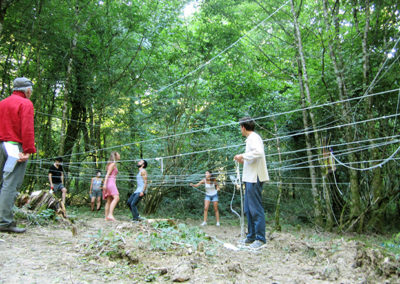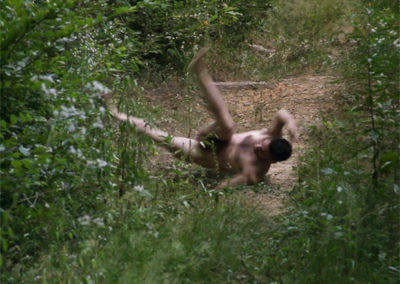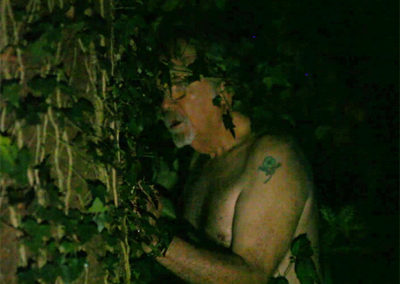Fron(t)daisons
La forêt fut longtemps le lieu des révoltés. À l’écart des remparts, les Robins et autres tire-laines médiévaux rejoignent dans notre imaginaire les maquisards ou les zadistes. Il ne s’agit pas ici d’énoncer des équivalences ou d’afficher un anachronisme de la pire espèce mais plutôt de souligner que la forêt accueille avec une bienveillance toute naturelle les réprouvés du système en place, tous les « hors remparts » en quelque sorte. Cabanes des Neg’ marrons de Guyane ou isbas bricolées des trappeurs sibériens fuyant la Kolyma, ces caches ombragées en disent long sur la vocation de la forêt d’accueillir la parole en lutte.
Mais plus que la nécessité de trouver un refuge à l’abri des regards de l’ordre, il s’agirait aussi de remonter le temps ; en somme, de nier l’évidence du cours des choses et de réécrire une autre histoire. Si les chasseurs-cueilleurs sont devenus des éleveurs « protégés » l’on pourrait imaginer que ce retour à la forêt est une tentative symbolique de réécrire l’histoire, une autre épopée serait alors possible où les villes et les États seraient davantage des communautés que des pyramides, des entités plus soucieuses du bonheur que de garantir le bien-être et la propriété pour reprendre la célèbre distinction aristotélicienne.
Revenir aux arbres pour refonder les villes en quelque sorte. Repartir à zéro disent les enfants ou le Gébé de l’an 01 ; la référence s’impose en ces temps du cinquantenaire de mai 1968. Revivre tout nu dans les futaies et les hautes fougères pour revivre l’Eden avant la chute et se dire que sortir couvert ne veut pas dire forcément recouvert, enseveli sous le lourd manteau des sociétés disciplinaires devenues aujourd’hui clairement sociétés du contrôle. Et, un jour, au creux des sous-bois, l’on sera heureux que « rien ne passe » et que l’on abandonne le sacro-saint portable pour oser des échanges réels : c’est quand « rien ne passe » que « ça se passe » dirait-on parodiant volontiers Lacan.
La forêt est lieu d’utopie et d’invention et, du Monte Verita au Black Mountain College, l’on s’est retiré des cités en fureur pour imaginer un enseignement sans contrainte institutionnelle. Ainsi si cette édition semble inquiète du bruit du monde, soucieuse par exemple des autres éditions de Back to the Trees qui, du Canada au Bangladesh, s’écrivent par forêts interposées, elle ne manifeste pourtant aucune hégémonie ni ne réclame aucune préséance. Nous souhaitons juste établir le constat d’un essaimage qui finalement nous rassure : les bois du Tout-Monde ne sont pas vidés des peuples en lutte. L’environnement n’est pas un décor et Spinoza n’en finit pas d’avoir raison contre Descartes : l’homme n’est pas un empire dans un empire.
Écologiquement parlant, tout ce qui arrive à la forêt nous touche un jour ; aussi espérons-nous culturellement que ce qui se dira et se montrera à l’abri des grands arbres vous touchera également de jour comme de nuit de discussions en enchantements.
Conçu par Elektrophonie et l’ISBA avec la complicité de nombreux partenaires dont cette année la municipalité de Saint-Vit et l’agglomération du Grand Besançon, notre Back to the Trees vous invitera à une déambulation toute pleine de surprises sonores et visuelles et nous rappellera – Rousseau n’est jamais loin de nous – que l’odeur de la chlorophylle est souvent celle de la liberté.
Espérons donc que le Bois d’Ambre saura cette année vous attirer toujours plus nombreux et fervents, tous les espoirs sont permis car après tout, les Grecs aux Bois Sacrés ne nommaient-ils pas l’ambre « elektron » (ἤλεκτρον), sensibles à ses propriétés centrifuges ?
Laurent Devèze
Les œuvres
• À Chamblay dans les Bois #2 • Évocations sonores de Clémence Culic (France)
• Albatros • Lecture et musique par le collectif La Méandre (France)
• Attractions • Performance en collaboration entre Christine Douxami (France), Guy Freixe (France) et des étudiants de Licence et Master d’arts du spectacle de l’Université de Franche-Comté (France)
• Barque #2 • Sculpture de Thomas Perrin (France)
• Bois sacré, les conséquences de l’objet • Installation plastique de Serge Galliot (France)
• Canne à Sel • Conte-poème d’Anooradha Rughoonundun (France)
• Chauve-Souris • Installation plastique de Mauro Corda (France)
• Création musicale spontanée de Xavier Martin (France)
• Éc(h)ographisme • Performance sonore et visuelle de Gilles Malatray (France) et David Bartholoméo (France)
• Écailles • Installation plastique de Julien Bouley (France)
• Frères des Arbres – L’Appel d’un Chef Papou • Film de Marc Dozier (France) et Luc Marescot (France)
• Frutas Exoticas • Sculptures de Myriam Grosso (France)
• Futaie Futée #4 • Installation sonore de l’Institut Supérieur des Beaux-Arts de Besançon (France)
• Hic et Nunc • Création sonore de Pierre-Laurent Cassière (France)
• Homo Narcisse • Sculpture de Dylan Merlano Leemans (France)
• Irradié. Voyageur immobile • Performance de Maxime Carasso (France)
• L’Invisible visible • Installation plastique de MarieCécile Casier (France)
• La Beste #3 • Sculpture de Vanly Tiene (Côte d’Ivoire)
• Le Bout du Monde • Dessins de Maureen Colomar (France)
• Le Chant du Lierre • Performance de Julien Blaine (France)
• Le Chemin de l’Ambre • Création sonore de l’école primaire Jouffroy d’Abbans (France) avec Aurélien Bertini (France) et Corsin Vogel (Suisse)
• Le Festin baroque • Conférence d’Anne-Lise Wuillamier (France) et Laurent Devèze (France)
• Le Pollen, témoin des paysages passés • Atelier scientifique de Fanny Duprat Oualid (France) et Emilie Gouriveau (France)
• Licorne • Théâtre et musique par Ciconia Théâtre (France)
• Mémoires d’Arbres • Installation vidéo de l’Institut Supérieur des Beaux-Arts de Besançon (France)
• Mouvements imaginaires • Installation plastique de Jean-Baptiste Fayol (France)
• Nature en Soi • Atelier de Miryam Eckert (France)
• Pattes d’Oiseaux • Installation plastique d’Anne-Claire Jullien (France)
• Pavillon Varese • Installation plastique et sonore de Corsin Vogel (Suisse)
• RandOlyric • Promenade chantée par Vincent Karche (France)
• Résines • Sculptures de Thomas Perrin (France)
• Shaking the Trees • Installation cinétique de Ben Farey (France)
• Station d’écoute en suspension • Installation sonore de Brane Project (France) et IdéeHaut (France)
• Street Life – Dans le Bras d’Eau • Lecture de Joseph Mitchell (États-Unis) par François Tizon (France)
• Structure atomique ordonnée • Installation plastique d’Alexandre Domini (France)
• Sysiphe • Performance de Claude Boudeau (France)
• Totems #2 • Sculptures de Julien Zoh Nihouah (France)
• Tous les hommes s’appellent Robert • Film de Marc-Henri Boulier (France)
• Un ornithologue perché dans un arbre • Création sonore d’Olivier Toulemonde (France)
• Vacío Pictório • Installation plastique de Valery Merlano Leeman (France)
• Wood • Installation plastique de Guillaume André (France)
• Xantos • Sculpture de Gérald Colomb (France)
Organisation
Elektrophonie et l’Institut Supérieur des Beaux-Arts de Besançon
avec la complicité de la commune de Saint-Vit, l’Université de Franche- Comté (VIVO ! Entrez en nature et CIMArtS), RandOlyric, la Citadelle de Besançon, l’Espace Multimédia Gantner, le Festival Atmosphères, Lato Sensu Productions et le Mouvement Colibris
Galerie photos
Station d’écoute en Suspension • Brane Project et IdéeHaut • 2018 • Saint-Vit • Photo de Benoît Grosjean
Attractions • Guy Freixe, Christine Douxami et des étudiants de Licence et Master d’arts du spectacle de l’Université de Franche-Comté • 2018 • Saint-Vit • Photo de Virginie Sansovini
Le pollen, témoin des paysages passés • Fanny Duprat Oualid et Emilie Gouriveau • 2018 • Saint-Vit • Photo de Pierre Acobas
Ec(h)ographisme • David Bartholoméo et Gilles Malatray • 2018 • Saint-Vit • Photo de David Bartholoméo
Foliage
For a long time, the forest was the place for rebels.
Away from the ramparts, the Robins and other medieval cutpurses join the maquisards and the direct action environmentalists in our imagination.
The point is not to declare equivalences or to flaunt an anachronism of the worst kind, but rather to emphasise that the forest naturally welcomes all outcasts of the current system. All the people “outside the walls”, so to speak.
The cabins of Neg’Marrons from French Guiana or the makeshift log huts of Siberian trappers fleeing the Kolyma – these shady hideouts speak volumes of the forest’s mission to accommodate the voice of the struggle.
But more than the need to find a refuge from the eyes of the order, it is also about going back in time. In short, denying the evidence of the course of events, and rewriting a different history.
If hunter-gatherers became students of husbandry, one can imagine that this return to the forest is a symbolic attempt to rewrite history. Another epic might be possible where towns and countries would be communities rather than pyramids, entities more sensitive to happiness rather than to guaranteeing welfare and property, to use the famous Aristotelian distinction.
Return to the trees to re-found the towns, so to speak. To start all over again, as children say, or Gébé from the comic strip “The Year 01”. The allusion is appropriate, now that we have reached the 50th anniversary of May 1968.
To live stark naked again, in the thickets and the high ferns, in order to relive Eden before the fall. To tell ourselves that to be dressed for the occasion doesn’t necessarily mean being covered, buried under the heavy mantle of disciplinary societies, which have clearly become societies of control. And – one day – in the depths of the undergrowth, we will be happy that “nothing is happening”. We will be happy to abandon the sacrosanct cellphone in order to dare to make real changes: it’s when “nothing is happening” that “it happens”, one might say, laconically paraphrasing Lacan.
The forest is the setting of utopia and invention. From Monte Verita to Black Mountain College, people have withdrawn from the cities in a fury to imagine an education without institutional constraint.
If this edition seems bothered by the noise of the world, mindful of the other “Back to the Trees”, which – from Kosovo to Bangladesh – are written by interposed forests, it still does not express any dominance or seek any precedence.
We only want to establish a spin-off which ultimately reassures us: the woods have not been emptied of people in their struggle. The environment is not a stage, and Spinoza never stops being correct in his dispute with Descartes: man is not an empire within an empire.
Ecologically speaking, everything that happens to the forest affects us at some point. We also hope that what is said and what is shown in the shelter of the large trees will touch you culturally, both in the daytime and during nocturnal discussions of enchantment.
Devised by Elektrophonie and the Besançon Institute of Fine Arts (ISBA) with the involvement of a number of partners, among them this year the municipalities of Saint-Vit and Besançon, Back to the Trees will invite you to a wandering about that is full of audio and visual surprises. It reminds us – Rousseau is never far away – that the smell of chlorophyll is often that of liberty.
Thus we hope that the Amber Forest will draw you this year in ever-growing numbers and enthusiasm. All hopes are permitted: after all, did not the Greeks in the Sacred Woods call amber “electron” (ἤλεκτρον), sensitive as they were to its centrifugal properties?
Laurent Devèze
Artworks
• Albatross • Reading and music by La Méandre (France)
• All Men are called Robert • Film by Marc-Henri Boulier (France)
• Attractions • Performance in collaboration with Christine Douxami (France), Guy Freixe (France) and Performing Arts students from Franche-Comté University (France)
• Bats • Installation by Mauro Corda (France)
• Boat #2 • Sculpture by Thomas Perrin (France)
• Brothers of the Trees – the Call of a Papuan Chief • Film by Marc Dozier (France) and Luc Marescot (France)
• Crafty Forest #4 • Literature installation by ISBA (France)
• Ec(h)ographics • Audio-visual performance by Gilles Malatray (France) and David Bartholoméo (France)
• Frutas Exoticas • Sculptures by Myriam Grosso (France)
• Hic et Nunc • Sound creation by Pierre-Laurent Cassière (France)
• Holy Wood, the Consequences of the Object • Installation by Serge Galliot (France)
• Homo Narcissus • Sculpture by Dylan Merlano Leemans (France)
• Imaginary Movements • Installation by Jean-Baptiste Fayol (France)
• In Chamblay in the Woods #2 • Poetic documentary by Clémence Culic (France)
• An Ornithologist in the Trees • Sound creation by Olivier Toulemonde (France)
• Irradiated. Immobile Traveller • Performance by Maxime Carasso (France)
• Listening Station in Suspension • Sound installation by Brane Project and IdéeHaut (France)
• Memories of Trees • Video installation by ISBA (France)
• Nature in and of itself • Workshop by Miryam Eckert (France)
• Pollen, Evidence of past Landscapes • Scientific workshop by Fanny Duprat Oualid (France) and Emilie Gouriveau (France)
• Porcelain • Sculptures by Thomas Perrin (France)
• RandOlyric • Singing stroll by Vincent Karche (France)
• Salt Cane • Poetic story by Anooradha Rughoonundun (France)
• Shaking the Trees • Kinetic installation by Ben Farey (France)
• Sisyphus • Performance by Claude Boudeau (France)
• Spontaneous musical Creation by Xavier Martin (France)
• Street Life – In the Stretch of Water • Reading of Joseph Mitchell (USA) by François Tizon (France)
• The “Beste” #3 • Sculpture by Vanly Tiene (France)
• The Amber Way • Sound creation by the Jouffroy d’Abbans primary school (France) with Aurélien Bertini (France) and Corsin Vogel (Switzerland)
• The Baroque Feast • Lecture by Anne-Lise Wuillamier and Laurent Devèze (France)
• The Edge of the World • Drawings by Maureen Colomar (France)
• The Invisible Visible • Installation by MarieCéile Casier (France)
• The Ivy’s Song • Performance by Julien Blaine (France)
• Totems #2 • Sculptures by Julien Zoh Nihouah (France)
• Unicorn • Musical show by Ciconia Theatre (France)
• Vacío Pictório • Sculpture by Valery Merlano-Leemans (France)
• Varese Pavilion • Sound and visual installation by Corsin Vogel (Switzerland)
• Wood • Installation by Guillaume André (France)
• Xantos • Sculpture by Gérald Colomb (France)
Organization
Elektrophonie and ISBA
with City of Saint-Vit, Franche- Comté University (VIVO ! Entrez en nature and CIMArtS), RandOlyric, Citadel of Besançon, Gantner Multimedia Center, Atmosphères Festival, Lato Sensu Productions and Colibris Movement



















